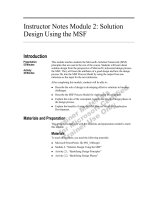Chuong5 2 Chapter 5.2: Network Design
Bạn đang xem bản rút gọn của tài liệu. Xem và tải ngay bản đầy đủ của tài liệu tại đây (1.66 MB, 81 trang )
Chapter 5.2:
Network Design
NGUYỄN CAO ĐẠT
E-mail:
Hochiminh City University Of Technology
Computer Science & Engineering
© 2014
Computer Networks 2
Chapter 5: Network Design
1
Outline
Logical Network Design
Design a network topology
Design models for addressing and naming
Select switching and routing protocols
Develop network security strategies
Develop network management strategies
Hochiminh City University Of Technology
Computer Science & Engineering
© 2014
Computer Networks 2
Chapter 5: Network Design
2
Network Topology Design Themes
Hierarchy
Redundancy
Modularity
Well-defined entries and exits
Protected perimeters
Hochiminh City University Of Technology
Computer Science & Engineering
© 2014
Computer Networks 2
Chapter 5: Network Design
3
Why Use a Hierarchical Model?
Reduces workload on network devices
Avoids devices having to communicate with too
many other devices (reduces “CPU adjacencies”)
Constrains broadcast domains
Enhances simplicity and understanding
Facilitates changes
Facilitates scaling to a larger size
Hochiminh City University Of Technology
Computer Science & Engineering
© 2014
Computer Networks 2
Chapter 5: Network Design
4
Hierarchical Network Design
Campus A
Enterprise WAN
Backbone
Core Layer
Campus B
Campus C
Campus C Backbone
Distribution
Layer
Access Layer
Building C-1
Hochiminh City University Of Technology
Computer Science & Engineering
© 2014
Building C-2
Computer Networks 2
Chapter 5: Network Design
5
Cisco’s Hierarchical Design Model
A core layer of high-end routers and switches that
are optimized for availability and speed
A distribution layer of routers and switches that
implement policies and segment traffic
An access layer that connects users via hubs,
switches, and other devices
Hochiminh City University Of Technology
Computer Science & Engineering
© 2014
Computer Networks 2
Chapter 5: Network Design
6
Star Hierarchical Topology
Corporate
Headquarters
Branch
Office
Hochiminh City University Of Technology
Computer Science & Engineering
© 2014
Home
Office
Branch
Office
Computer Networks 2
Chapter 5: Network Design
7
Flat Versus Hierarchy
Headquarters
in Medford
Headquarters
in Medford
Grants Pass
Branch Office
Klamath Falls
Branch Office
Ashland
Branch
Office
Flat Loop Topology
Hochiminh City University Of Technology
Computer Science & Engineering
© 2014
Grants Pass
Branch
Office
Klamath Falls
Branch Office
Ashland
Branch
Office
White City
Branch Office
Hierarchical Redundant Topology
Computer Networks 2
Chapter 5: Network Design
8
Mesh Designs
Partial-Mesh Topology
Full-Mesh Topology
Hochiminh City University Of Technology
Computer Science & Engineering
© 2014
Computer Networks 2
Chapter 5: Network Design
9
A Partial-Mesh Hierarchical Design
Headquarters
(Core Layer)
Regional
Offices
(Distribution
Layer)
Branch Offices (Access Layer)
Hochiminh City University Of Technology
Computer Science & Engineering
© 2014
Computer Networks 2
Chapter 5: Network Design
10
Avoid Chains and Backdoors
Core Layer
Distribution Layer
Access Layer
Chain
Hochiminh City University Of Technology
Computer Science & Engineering
© 2014
Backdoor
Computer Networks 2
Chapter 5: Network Design
11
How Do You Know When You Have a
Good Design?
When you already know how to add a new
building, floor, WAN link, remote site, e-commerce
service, and so on
When new additions cause only local change, to
the directly-connected devices
When your network can double or triple in size
without major design changes
When troubleshooting is easy because there are no
complex protocol interactions to wrap your brain
around
Hochiminh City University Of Technology
Computer Science & Engineering
© 2014
Computer Networks 2
Chapter 5: Network Design
12
Cisco’s SAFE Security Reference Architecture
Hochiminh City University Of Technology
Computer Science & Engineering
© 2014
Computer Networks 2
Chapter 5: Network Design
13
Campus Topology Design
Use a hierarchical, modular approach
Minimize the size of bandwidth domains
Minimize the size of broadcast domains
Provide redundancy
Mirrored servers
Multiple ways for workstations to reach a router
for off-net communications
Hochiminh City University Of Technology
Computer Science & Engineering
© 2014
Computer Networks 2
Chapter 5: Network Design
14
Virtual LANs (VLANs)
An emulation of a standard LAN that allows data
transfer to take place without the traditional
physical restraints placed on a network
A set of devices that belong to an administrative
group
Designers use VLANs to constrain broadcast traffic
Hochiminh City University Of Technology
Computer Science & Engineering
© 2014
Computer Networks 2
Chapter 5: Network Design
15
VLANs Span Switches
VLAN A
Station A1
Station A2
VLAN A
Station A3
Station A4
Station A5
Switch A
Station B1
Station A6
Switch B
Station B2
VLAN B
Hochiminh City University Of Technology
Computer Science & Engineering
© 2014
Station B3
Station B4
Station B5
Station B6
VLAN B
Computer Networks 2
Chapter 5: Network Design
16
WLANs and VLANs
A wireless LAN (WLAN) is often implemented as a
VLAN
Facilitates roaming
Users remain in the same VLAN and IP subnet as
they roam, so there’s no need to change
addressing information
Also makes it easier to set up filters (access control
lists) to protect the wired network from wireless
users
Hochiminh City University Of Technology
Computer Science & Engineering
© 2014
Computer Networks 2
Chapter 5: Network Design
17
Workstation-to-Router Communication
Proxy ARP (not a good idea)
Listen for route advertisements (not a great idea
either)
ICMP router solicitations (not widely used)
Default gateway provided by DHCP (better idea
but no redundancy)
Use Hot Standby Router Protocol (HSRP) for redundancy
Hochiminh City University Of Technology
Computer Science & Engineering
© 2014
Computer Networks 2
Chapter 5: Network Design
18
HSRP
Active Router
Enterprise Internetwork
Virtual Router
Workstation
Standby Router
Hochiminh City University Of Technology
Computer Science & Engineering
© 2014
Computer Networks 2
Chapter 5: Network Design
19
Multihoming the Internet Connection
ISP 1
Enterprise
ISP 1
ISP 1
Option A
ISP 2
Enterprise
Enterprise
ISP 1
Paris
Option B
Hochiminh City University Of Technology
Computer Science & Engineering
© 2014
Paris
Enterprise
NY
Option C
ISP 2
NY
Option D
Computer Networks 2
Chapter 5: Network Design
20
Security Topologies
DMZ
Enterprise
Network
Internet
Web, File, DNS, Mail Servers
Hochiminh City University Of Technology
Computer Science & Engineering
© 2014
Computer Networks 2
Chapter 5: Network Design
21
Security Topologies
Internet
Firewall
DMZ
Hochiminh City University Of Technology
Computer Science & Engineering
© 2014
Web, File, DNS, Mail Servers
Enterprise Network
Computer Networks 2
Chapter 5: Network Design
22
Outline
Logical Network Design
Design a network topology
Design models for addressing and naming
Select switching and routing protocols
Develop network security strategies
Develop network management strategies
Hochiminh City University Of Technology
Computer Science & Engineering
© 2014
Computer Networks 2
Chapter 5: Network Design
23
Guidelines for Addressing and Naming
Use a structured model for addressing and naming
Assign addresses and names hierarchically
Decide in advance if you will use
Central or distributed authority for addressing and
naming
Public or private addressing
Static or dynamic addressing and naming
Hochiminh City University Of Technology
Computer Science & Engineering
© 2014
Computer Networks 2
Chapter 5: Network Design
24
Advantages of Structured Models for
Addressing & Naming
It makes it easier to
Read network maps
Operate network management software
Recognize devices in protocol analyzer traces
Meet goals for usability
Design filters on firewalls and routers
Implement route summarization
Hochiminh City University Of Technology
Computer Science & Engineering
© 2014
Computer Networks 2
Chapter 5: Network Design
25









